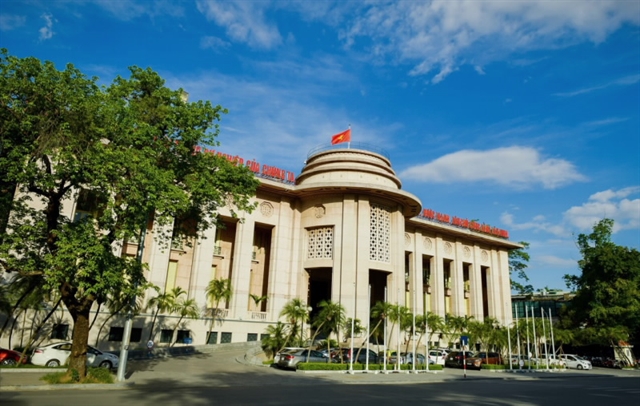 Economy
Economy


|
| Headquarters of the State Bank of Vietnam (SBV) in Hà Nội. One of the provisions of the draft Law on Credit Institutions is the SBV’s right to make early intervention to credit institutions in some cases. Photo sbv.gov.vn |
HÀ NỘI — The draft revised Law on Credit Institutions regulates the application of early intervention to credit institutions which fail to maintain the solvency ratio after facing massive money withdrawals, with an aim to prevent worse consequences.
One of the provisions of the draft law, which is being submitted to the National Assembly for consideration, is the State Bank of Vietnam (SBV)’s right to make early intervention to credit institutions in several cases: when credit institutions face massive withdrawal which result in insolvency; when they cannot maintain the payout ratio and capital adequacy ratio for three and six consecutive months; and when they have an accumulated loss higher than 20 per cent of the charter capital value and reserve funds.
In the cases, the SBV, Deposit Insurance of Vietnam and other credit institutions can provide special loans, with no collateral, with an interest rate of zero per cent.
According to the SBV, the provision was designed by the drafting board after considering recent events during the restructuring of weak credit institutions, as well as the massive money withdrawal at Saigon Commercial Bank (SCB) in October 2022.
The drafting board also referred to the collapse of many banks internationally, including the collapse of some US banks recently.
The SBV said the draft law is aimed to ensure there is a legal framework to promptly respond to major risks arising, such as the case of a credit institution that has a massive money withdrawal and threatens the safety of the banking system.
The early intervention not only helps the credit institutions have a chance to get rid of the worse risk, but also helps neutralise the risk of spreading to the whole banking system and the economy, which will be very costly in terms of resources and time to fix.
Dr. Lê Duy Bình, director of Economica Vietnam, said under the current roles, functions, duties and regulations, it is not easy for the SBV to quickly, decisively and effectively support credit institutions.
Citing the experience of countries such as Switzerland and the United States (where there have been cases of collapsed banks recently), Bình said the reason the countries could react and solve the problems of the collapsed banks very quickly is that the countries have already issued mechanisms and regulations in different laws to solve the problems. In order to handle the cases in just a few days like that, the countries must have a legalised mechanism in place and a ready frameworks for quick decisions when such situations arise.
From the cases in both the world and Việt Nam, it is necessary to have immediate measures to ‘put out the fire’, Bình said, adding it is indispensable and there is no doubt about building an early intervention regulation in the draft Law on Credit Institutions.
Banking expert Dr. Cấn Văn Lực also agreed with the early intervention regulation in the draft law, saying early warning and early intervention is very important because this is a measure to prevent risks to become worse.
According to Lực, early interventions need to ensure three requirements: fast and timely; right dose; and effectiveness. In order to ensure the above requirements, one of the very important factors is to give sufficient authority to the SBV so when a very bad situation happens to a credit institution, the SBV will not have to take a long time to ask for opinions of relevant ministries, branches and the Government, which can cause the handling of the problem too late and the consequences will be worse.
The Law on Credit Institutions was issued in 2010 and currently also shows a number of limitations, requiring amendments to suit the actual operation of credit institutions and management practices of State agencies.
The law’s regulations on organisation, administration and operation of credit institutions overlap with other laws including Law on Enterprises and Law on Cooperatives.
Besides, since 2010, other relevant laws, such as the Law on Enterprises, Law on Investment and Law on Management and Use of State Capital for Investment in Production and Business of Enterprises, have been amended, supplemented or replaced. Therefore, some provisions of the Law on Credit Institutions also need to be revised to ensure consistency with the above laws. — VNS